Practice Test for Texes English Language Arts and Reading 7-12
Accept the ELAR 7-12 Practise Examination
Welcome to our TExES ELAR vii-12 practice test and prep page. On this page, we outline the domains and central concepts for the ELAR seven-12 exam. Information technology is a free resource nosotros provide so you can see how prepared you are to take the official test.
While this free guide outlines the competencies and domains plant on the test, our paid TExES ELAR 7-12 study guide covers EVERY concept you need to know and is prepare to ensure your success! Our online TExES ELAR 7-12 study guide provides exam-aligned study material using interactive aids, videos, wink cards, quizzes and practise tests.
Will I pass using this complimentary commodity? Will I laissez passer using your paid study guide?
If you lot employ this guide and research the key concepts on the TExES ELAR 7-12 on your own, it'due south possible yous will pass, but why take that risk? With our paid study guide, nosotros guarantee y'all will pass.
→ Subscribe Now: TExES ELAR 7-12 Study Guide
Quick Links to Assistance You lot Navigate This Page
- TExES ELAR 7-12 Information
- ELAR seven-12 Domain I: Integrated Language Arts, Various Learners, and the Study of English language
- ELAR vii-12 Domain II: Literature, Reading Processes, and Skills for Reading Literary and
Nonliterary Texts - ELAR 7-12 Domain Three: Written Communication
- ELAR seven-12 Domain IV: Oral Communication and Media Literacy
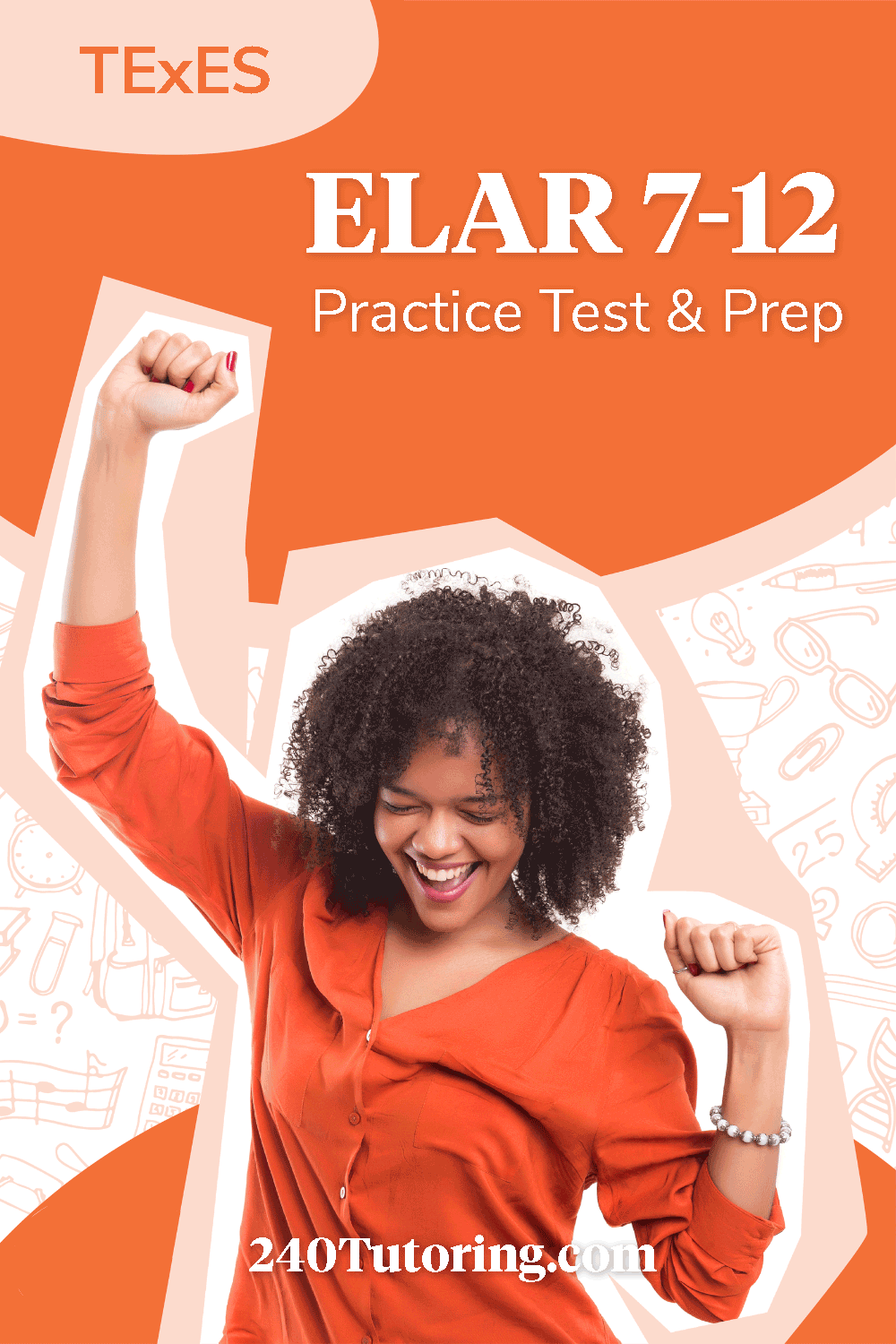
Overview
The exam assesses a candidate'due south knowledge of the given subject in order to show their competence to teach the field of study. TheTExES English Language Arts and Reading 7-12 examination focuses on the areas of literature, written and oral communication, and more.
Format:
The exam is a computer-based exam with 100 multiple selection questions and two constructed response questions; one covers literary analysis and the other is a three-office writing assessment. The allotted fourth dimension to finish the exam is five hours.
Cost:
The exam costs $116 to be paid using a credit or debit card.
Scoring:
The minimum scaled score to pass is a 240.
Study time:
In social club to pass theTExES ELAR 7-12 assessment, the amount of fourth dimension needed to study will vary from person to person. Be sure to give yourself at least two months fourth dimension to adequately prepare.
What test takers wish they'd known:
- Review all test-taking policies well in advance of arriving to the testing centre
- Assure yous've brought needed materials, including required identification
- Enquiry routes and traffic patterns and let yourself plenty of time to travel to the testing center
- Dress in layers
- Detect your confidence and take the test with a positive attitude!
Information obtained from the Pearson website.
Overview
Domain I has nigh 15 questions which accounts for well-nigh 15% of the entire ELAR 7-12 test.
This domain contains iii competencies:
- Integrating ELA Instruction
- Instructing Diverse Students
- Understanding the Structure and Evolution of English
So, let'southward talk about Integrating ELA Instruction outset.
Integrating ELA Teaching
This competency tests your knowledge of integrating ELA pedagogy.
Take a look at these concepts that are likely to appear on the test.
Texas Essential Cognition and Skills (TEKS)
It is important to understand the continuum of linguistic communication arts skills and expectations for students in grades 7-12, as specified in the TEKS.
Let'southward expect at how a specific skill, using print or digital resources, expands across the grade levels:

Writing and Math
Integrating writing in math form allows for a educatee to communicate what they know well-nigh math concepts and problem-solving. If a educatee can communicate their learning in writing then that pupil truly understands what has been taught. There are 2 levels of integrating writing in a math course. The first level is writing without revision which can hands be integrated into a math classroom and the second level is writing with revision (which will accept more than time). The complete writing process should be present in the math classroom.

Instructing Diverse Students
This competency tests your cognition of instructing various students.
Allow's talk well-nigh some super important concepts.
ELPS-TELPAS Proficiency Level Descriptors
The 4 domains for ELPS are reading, writing, speaking, and listening. Students who are labeled as ELs (English language learners) or LEP (express English expert) will accept the TELPAS assessment every year and exist graded on each i of these domains. The levels that a student can achieve are beginning, intermediate, advanced, and advanced high. Each domain has unlike criteria in order for a educatee to meet the requirements for their level. The link below connects you lot to a guide with each domain and descriptors for each level. You will be required to recall the descriptors on the exam.
Assignment Modifications
A modification describes changes in the curriculum. This may include altering the standards or a given assessment. Within a classroom, modifications could exist shortening assignments or providing lower-level text to read. This is done for students with cognitive impairments or language barriers due to their disability to learn all material or detail portions of the cloth presented.
An adaptation alters how a student learns. This does not change what a student is expected to learn. An accommodation may be providing extra time to complete assignments, breaks during didactics, and using big impress books and worksheets.
Understanding the Construction and Evolution of English
This competency tests your knowledge of understanding the structure and development of English.
Exist sure to sympathise the post-obit concepts.
Homonyms
Homonyms are words that are spelled the aforementioned way or pronounced the same fashion merely have different meanings or origins. Homophones are words that are pronounced the same way but have different spelling and a different pregnant. For instance, break is the motion of slowing down, and pause is to separate into pieces.Homographs are words spelt the same but have different discussion meanings. For case, tear is to rip or a driblet of water from the eye. Information technology is important to teach students the relationships among words so that they can understand what discussion or definition they should utilise in the context that is appropriate.

Sentence Structure
The most basic parts of any sentence are the subject and the predicate. The subject is the person, place, or thing that is performing the activity, while the predicate is what the bailiwick is doing. There are four different kinds of sentences: simple, compound, complex, and chemical compound-circuitous.
Simple Sentences
-
- One independent clause: ane subject area and one verb
- Cannot accept any subordinate clauses
- Examples:
- Ellen DeGeneres and Steve Harvey host talk shows.
- Joe Jonas waited for the motorcoach.
Compound Sentences
-
- Two or more independent clauses
- Clauses can be joined using coordinating conjunction: for, and, nor, but, or, yet, so
- Clauses tin can exist joined using a semicolon
- Cannot have any subordinate clauses
- Examples:
- I really need to become to work, merely I am too ill to drive.
- The waves were crashing on the shore; information technology was a lovely sight.
Complex Sentences
-
- One independent clause and at least one dependent clause
- Utilize subordinating conjunctions to link ideas
- Examples:
-
-
- Parallel lines never meet until yous bend 1 of them.
-
-
-
- Many dead animals of the by inverse to oil while others preferred to be gas.
-
Chemical compound-Complex Sentences
-
- At least two independent clauses and 1 dependent clause
- A dependent clause can exist office of an independent clause
- Examples:
- When the heat comes, the lakes dry up, and farmers know the crops will fail. I planned to drive to piece of work, but I couldn't until the mechanic repaired my car. And that's some bones info about the first domain of the English Language Arts 7-12test.
Overview
Domain II has about 40 questions which accounts for about 40% of the entire ELAR 7-12 test.
This domain contains four competencies:
- Teaching Reading Processes
- Education Strategies for Reading Nonliterary Texts
- Agreement Literary Texts
- Education Strategies for Reading and Responding to Literary Texts
So, let'south talk about Teaching Reading Processes first.
Didactics Reading Processes
Fluency is the ability to read similar yous speak. An authentic reading of the text at a conversational rate with advisable expression. The three components of reading fluency are accuracy, automaticity, and prosody. Accuracy refers to reading words correctly. Automaticity means recognizing words automatically. Prosody refers to reading with intonation, phrasing, and emotion. Fluency enables students to increment their level of comprehension, expand their vocabulary, and complete reading tasks effectively. Middle school and high school fluent readers are more proficient at circuitous literary processes that crave deep comprehension skills.
Instructional Strategies to Raise Fluency:
- Student-Recorded Passages: (Hudson, et al., 2005) Once students sympathise what adept reading sounds like, the next step toward fluency is for the students to listen to themselves read. Many students at the middle and high school levels have neverlistened tothemselves read text aloud. In other words, if they're not paying attention to how they sound, they won't actuallyknow how they sound. A educatee-teacher conference that includes listening to the tape-recording, discussing the educatee'southward reflection, and analyzing strengths and weaknesses in fluency can serve as a goal-setting opportunity during which the teacher tin can exist explicit well-nigh the dissimilar components of fluency. This starting time recording can also be saved to demonstrate improvement in fluency over time.
- Choral Reading: (Rasinski, 2003) Choral reading is an action in which students (whole form or small-scale groups) read the same text aloud and in unison. Dependent on the level of complication of the text, as the teacher readsalongwith the students, s/he may readmore or less loudly to serve every bit a model for the students to use as they read. The only boosted requirement is that each of the students has access to the text that is being read. Each pupil can have a personal copy of the text or the teacher tin can write the text on chart paper / Smartboard where each pupil can see it. For middle school and loftier school students, choral reading is particularly appropriate with complex text that students are not still set up to read independently.
- Paired Reading: (Fountas & Pinnell, 2006; Rasinski, 2003) Typically, this is an action in which partners read aloud to or along with one some other. If the pair of students share the same reading level, they should have text that is at their contained level. They can choose to choral read, echo read, or have turns reading the designated passage. Be certain they end and discuss their fluency along the manner. Some other way to pair students is to place an "adept" with a less fluent reader. The less fluent reader chooses the text and the good adjusts their pace to that of the less fluent reader. If an mistake is made, the skilful provides the right pronunciation speedily, and then as not to disrupt fluency. The expert or tutor can be a parent, an adult volunteer, the instructor, or fifty-fifty another pupil.
Education Strategies for Reading Nonliterary Texts
This competency tests your noesis of instruction strategies for nonliterary text.
Check out the post-obit concept.
Nonliterary Text Structure
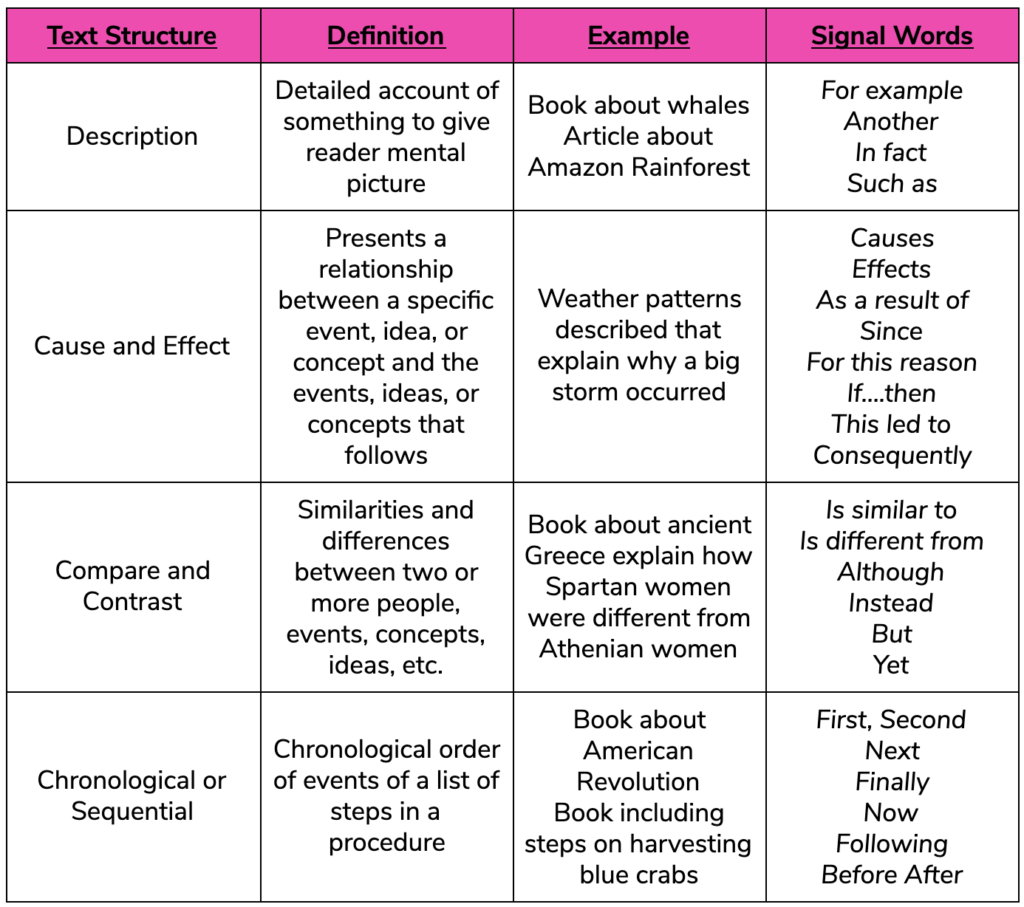
Understanding Literary Texts
This competency tests your cognition of understanding literary text.
Exist sure to understand the post-obit concepts, as they are likely to appear on the exam, too.
Major Genres and Their Characteristics
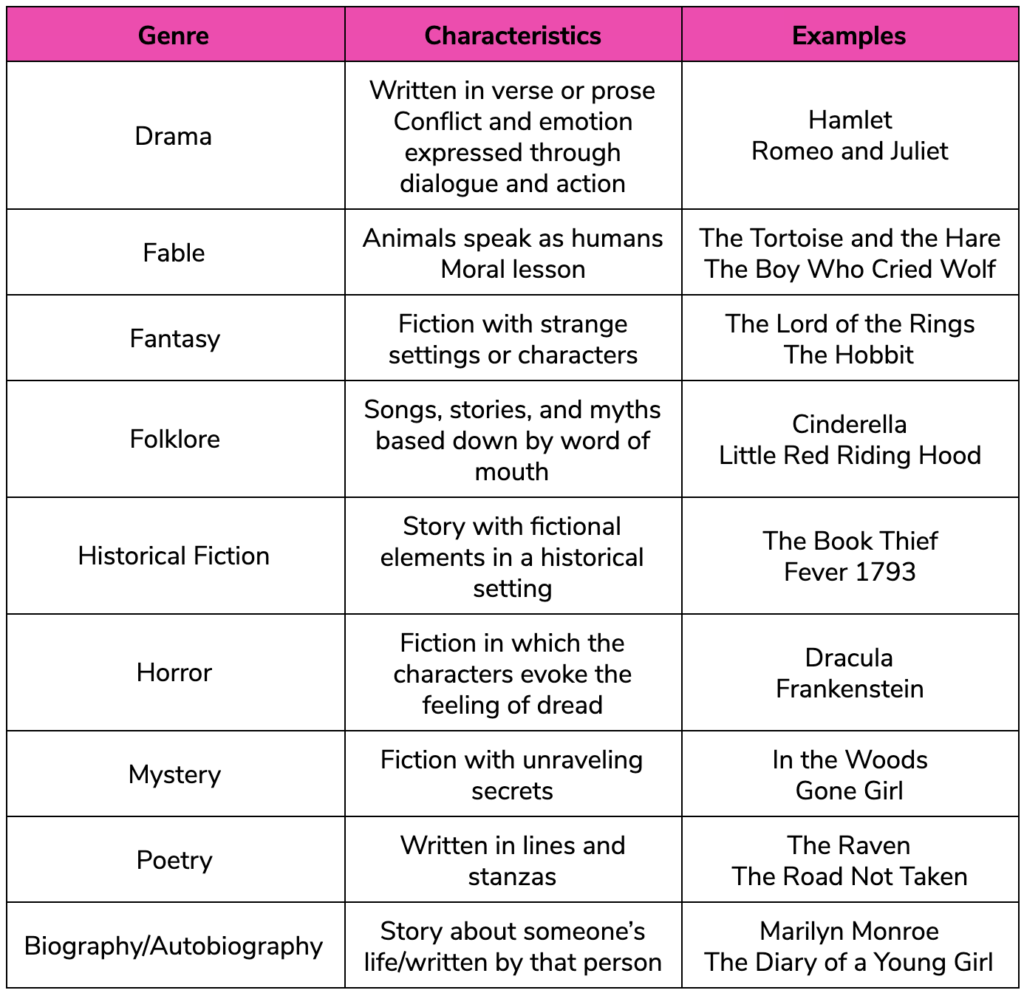
Americadue north Literary Periods
The Colonial and Early on National Menstruum (17th century to 1830)
- Consisted by and large of applied nonfiction
- Written past British settlers who populated the colonies, focusing on the future
- Once the U.S. declared independence the writing addressed the country's future
- Verse and fiction was modeled later on what was being published in Peachy United kingdom of great britain and northern ireland and much of what Americanorthward readers consumed also came from Great Britain
- Short stories and novels published from 1800-1820s depicted American society
The Romantic Period (1830 to 1870)
- Edgar Allan Poe wrote in the Gothic tradition and depicted the role of the Romantic individual, always struggling confronting convention
- In New England, different groups of writers emerged, exploring the experiences of individuals in different segments of American society
- Nathaniel Hawthorne, Herman Melville, and Walt Whitman published novels, short stories, and poetry that became some of the well-nigh enduring works of American literature
- As America headed toward the Ceremonious War, more than and more stories were written about enslaved and free African Americans
- Emily Dickinson was an American poet
Realism and Naturalism (1870 to 1910)
- At the historic period of 27, Samuel Clemens became Mark Twain, writing with a combination of sense of humor and realism
- Drew inspiration from French authors, like Zola, seeking to depict the reality that they saw around them
The Modernist Catamenia (1910 to 1945)
- Americanorth modernist fiction portrays a sense of disillusionment and loss
- Drama became very popular in the United states in the early on 20th century
The Contemporary Period (1945 to nowadays)
- Black writers working from the 1950s through the 1970s wrestled with the desire to escape an unjust club and change it
- Later on World War 2 different forms of writing emerged: realist, metafictional, postmodern, absurdist, autobiographical
- The Crush movement was short-lived but had a lasting influence on Americanorth poetry
- By the 1970s the face of American drama had begun to change and information technology continued to diversify into the 21st century
Teaching Strategies for Reading and Responding to Literary Texts
This competency tests your knowledge of teaching strategies for reading and responding to literary texts.
Take a wait at these concepts that are likely to appear on the test.
Motivating Students to Read Literature
Build Students' Self-Conviction
- When learners believe they tin can achieve, they do achieve
- Establish specific, short-term reading goals. Goals should be challenging merely attainable
- Introduce a diversity of graphic organizers or notation-taking strategies to help students better sympathise what they are learning
- Let students to make choices using selection boards, flexible grading, self-determined due dates
Spark New Learning
- Apply a variety of instructional practices that embrace multiple forms of literacy
- Students' interests should be the starting point for reading didactics
Build Connections
- Make a connection between a pupil'southward personal life and their school life by addressing topics relevant to the subject and to the students' reality
Go Beyond the Print
- Encourage students to make connections to popular movies based on literature
- Explore ways to promote reading through dissimilar engineering science sources
Contain a Variety of Texts
- Include a variety of appropriate, authentic young literature including graphic novels, newspapers, and magazines
Expand Choices and Options
- Give students a option as to what to read
- Include all literary genres and various reading levels
- Each student volition have a slightly different experience based on the literature selected which volition promote lively discussions and writings increasing reading motivation
Promote Conversations
- Provide purposeful opportunities for students to talk almost books enhances their date
Responding to Literature
In that location are diverse means that students tin can respond to literature that ranges from vocabulary edifice to writing their ain piece. Below are a couple of different examples likewise as a link to many more.
10 Words: write 10 words from the reading that you do non know. Define them, use them in a judgement you lot created, and write the judgement in which you institute the give-and-take.
Make Connections: make connections with your own experience as you read. Ask questions similar: do the characters remind you of anyone in your life? Do the conflicts the characters face chronicle to the problems you have experienced?
Choose a "Truth": decide a "truth" that you believe this writer holds to exist true. Write a persuasive essay in which y'all concord or disagree with that "truth."
And that's some basic info virtually Domain II on the ELAR 7-12 test.
Overview
Domain III has most xxx questions which accounts for about xxx% of the entire ELAR 7-12 examination.
This domain contains 2 competencies:
- Developing Competent Writers
- Instruction Effective Writing
So, let's talk about Developing Competent Writers first.
Developing Competent Writers
This competency tests your knowledge of developing competent writers.
Here are a couple of specific concepts you need to know.
Misplaced Modifiers
A misplaced modifier is a discussion, phrase, or clause that is improperly placed in a judgement. A misplaced modifier tin can make a sentence sound awkward, confusing, and sometimes illogical.
Examples:
Misplaced Modifier:On her way abode, Jan found a gold man'southward watch.
Correct Judgement:On her manner home, Jan establish a man's gold watch .
Misplaced Modifier:The child ate a cold dish of cereal for breakfast this morning time.
Correct Sentence:The child ate a dish of cold cereal for breakfast this morning.
Misplaced Modifier:Nosotros ate the lunch that we had brought slowly .
Correct Sentence:We slowly ate the dejeuner that we had brought.
Misplaced Modifier:The dealer sold the Cadillac to the buyer with the leather seats .
Correct Judgement:The dealer sold the Cadillac with the leather seats to the buyer.
Misplaced Modifier:The waiter served a dinner whorl to the woman that was well buttered.
Correct Sentence:The waiter served a dinner curlicue that was well buttered to the woman.
Writing Assessment
Teachers have the choice to assess students' writing on a multifariousness of concepts including ideas, voice, organization, word choice, sentence fluency, and conventions. This can exist done formally or informally. It is imperative that a teacher establishes the focus of the writing and what the educatee volition be assessed on prior to students starting their writing. Here is a resource that provides rubrics and unlike ideas on how to assess students on their writing.
Education Effective Writing
This competency tests your knowledge of teaching effective writing.
Let'southward talk almost two concepts that yous will more than likely see on the exam.
Types of Phrases
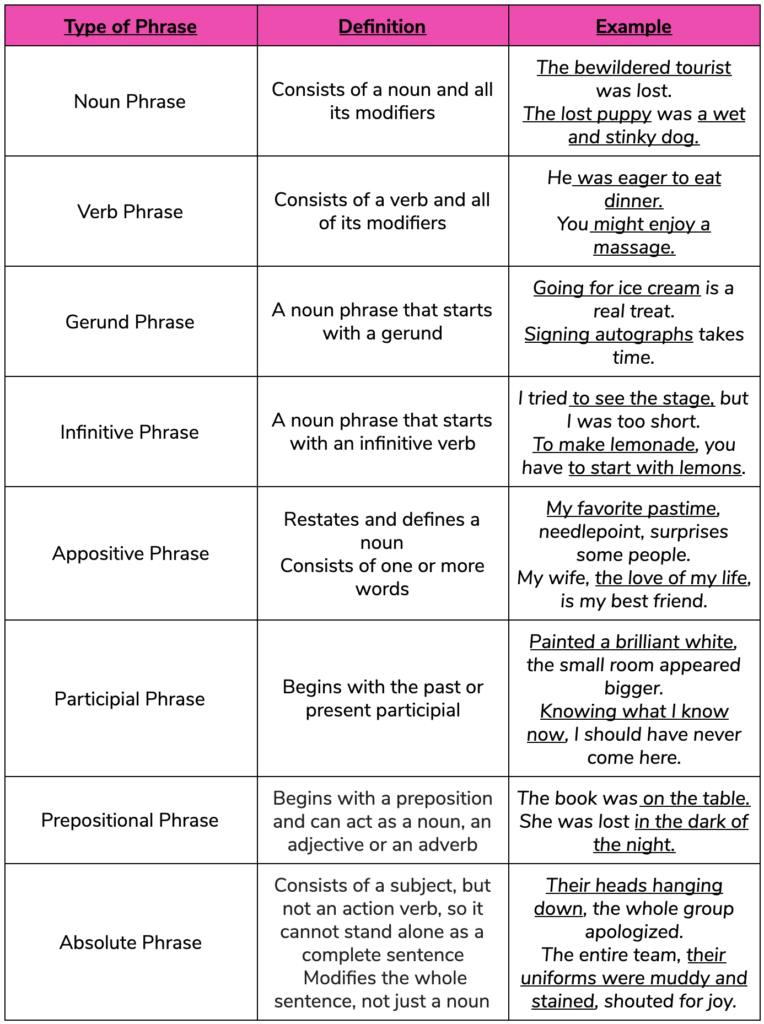
Teachers can use sentence imitation, poetry with phrases, skeleton stories, shape sentences, and unscrambling and expansion to help teach students to include a variety of phrases in their writing.
Literary Devices in Writing
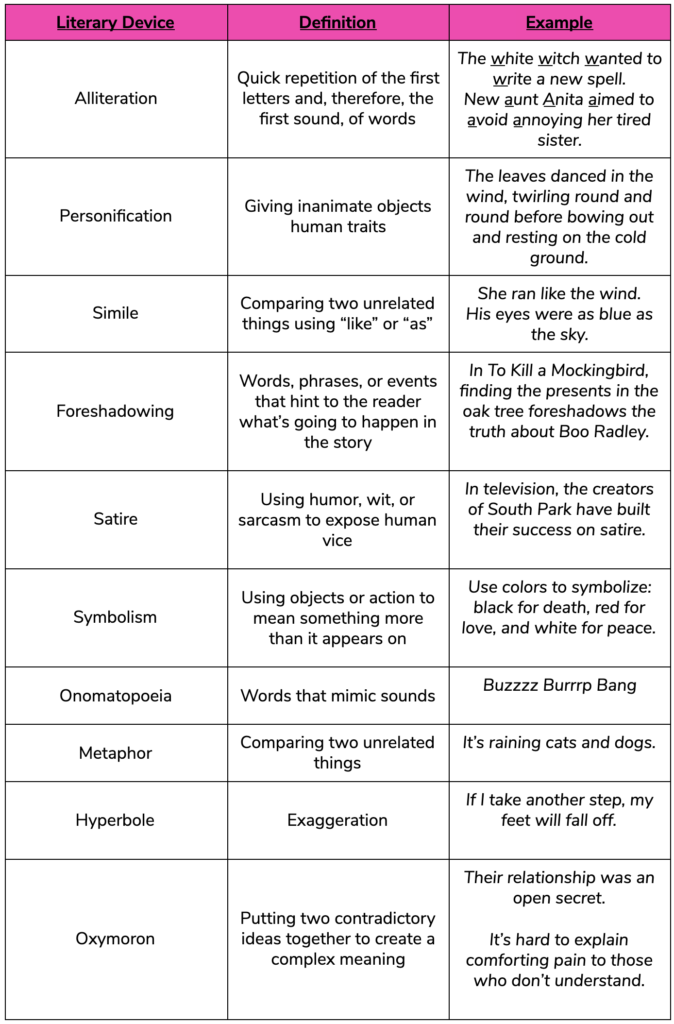
And that's some basic info about Domain 3 of the ELAR 7-12 exam.
Overview
Domain 4 has about 15 questions which accounts for nigh 15% of the unabridged test.
This domain contains 2 competencies:
- Promoting Listening and Speaking Skills
- Instruction Media Literacy
So, let's talk about Promoting Listening and Speaking Skills first.
Promoting Listening and Speaking Skills
This competency tests your knowledge of promoting listening and speaking skills.
Let's talk over a couple of concepts.
The Part of Cultural Factors in Oral Advice
Cultural factors affect oral advice greatly. For instance, some cultures rely heavily on electronic technology and use written messages over oral or contiguous communication. Notwithstanding, there are nations that take access to the latest technology but prefer face-to-face advice.
Cultural factors also influence the blazon of agreements that are binding equally formal contracts. High-context cultures like Latin American, African, and Asian cultures go out much of the message to be interpreted through context, nonverbal cues, and between the lines. In contrast, low-context cultures like German and English expect letters to exist specific and explicit.
How Culture Impacts Oral Communication inside the English Language:
Indians and Japanese tend to use more nouns which make the language heavy and cumbersome; native users of the language, on the other manus, apply more verbs which make the language more direct and dynamic.
Japanese:The police conducted an investigation into the murder.
English language:The police investigated the murder.
Native users of English prefer the active voice whereas Asian users tend to use the passive vocalism more than. This straight relates to how they communicate in their own linguistic communication.
Asian:Permit the pecker to be paid by me.
English language:Let me pay. I'll pay.
Japanese and Indians notice it rather more difficult to say "no" directly. It can sound rude or "in your confront". They would rather imply a negative than say it out loud. This tin cause misunderstandings equally westerners sometimes might assume a deal is done and dusted, whereas at that place was never a "yes" unsaid.
Resource
Active Listening
Agile listening is when you make a conscious attempt to hear the words that someone is proverb and understand the complete message beingness communicated. This is important considering it impacts job effectiveness and the quality of relationships with others. Teachers tin model and encourage the use of active listening past focusing on their students when they are speaking in a couple of unlike ways.
Examples of How to Be an Agile Listener:
- Pay Attending: look students in the eye, put aside distracting thoughts, avoid environmental distractions
- Show That You're Listening: nod, smile, go on posture direct showing the speaker you are interested and engaged
- Provide Feedback: reflect on what was said by paraphrasing, ask questions to clarify, summarize comments periodically
- Respond Accordingly: exist open and honest, assert your opinions, treat the other person the same manner yous desire to exist treated
Didactics Media Literacy
This competency tests your knowledge of education media literacy.
Check out the following important concepts.
Types and Purposes of Media
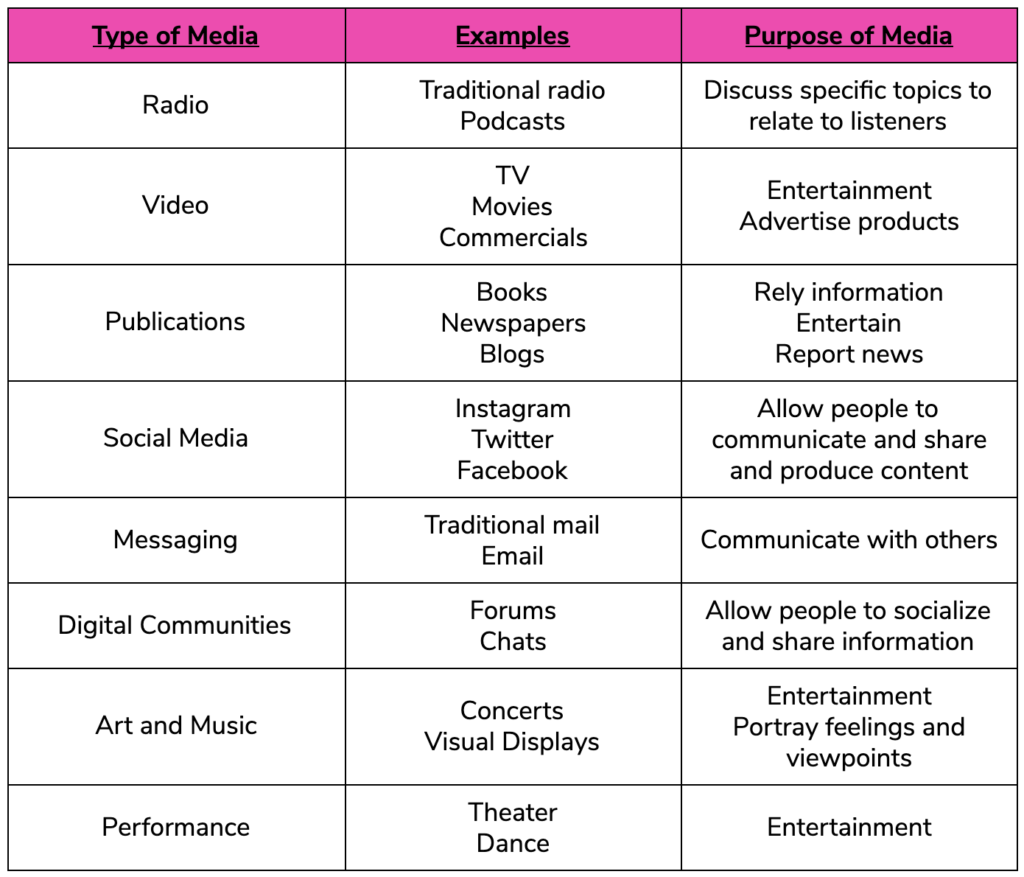
Off-white Use
Off-white utilise is cursory excerpts of copyright cloth that may be directly quoted without the demand for permission from the copyright holder. Section 107 of the Copyright Act provides the framework for determining when something is fair use and identifies the type of utilize including news reporting, instruction, and research. Although teaching is ane of the types of uses covered nether fair use, teachers do need to consider it when they are planning and during their teaching. Before a teacher uses copyright information in their planning and education they must consider whether it is for strictly nonprofit educational purposes, the nature of the copyrighted work, the corporeality of the copyrighted piece of work beingness used, and the effect of the utilize of the potential market.
And that's some basic info about Domain Iv in the ELAR 7-12 examination.
Take the ELAR 7-12 Practice Exam
Source: https://www.240tutoring.com/texes-prep/texes-english-language-arts-and-reading-7-12-ultimate-guide/
Postar um comentário for "Practice Test for Texes English Language Arts and Reading 7-12"